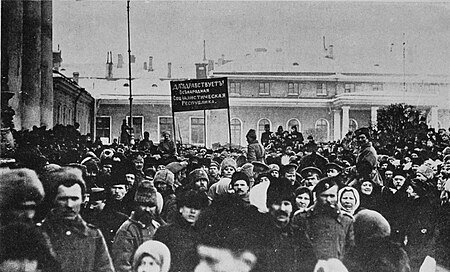The year 1917 marked a turning point in Russian history with the February Revolution. On February 23rd, 1917, widespread protests and strikes erupted in Petrograd (now Saint Petersburg), setting in motion a series of events that would shape the destiny of the nation. This revolution ultimately led to the abdication of Tsar Nicholas II, bringing an end to centuries of Romanov rule and paving the way for the establishment of a provisional government.
The February Revolution was a result of various factors that had been brewing for years. Russia was facing economic hardships, food shortages, and the strain of World War I. The working class, peasants, and soldiers had grown disillusioned with the Tsarist regime and its inability to address their grievances. These frustrations culminated in mass demonstrations and strikes, demanding political and social reforms.
One of the key catalysts for the revolution was the International Women’s Day protest on February 23rd, 1917. Thousands of women took to the streets of Petrograd, demanding bread and better working conditions. Their peaceful demonstration quickly turned into a city-wide strike, as workers from various industries joined in solidarity. The protests gained momentum and spread throughout the city, with people from all walks of life voicing their discontent.
The Tsarist government responded with force, but their attempts to suppress the uprising only fueled the flames of revolution. The military, which had long been a pillar of support for the Tsar, began to waver in its loyalty. Soldiers refused to fire upon the protesters and instead joined their ranks, further weakening the Tsar’s grip on power.
As the revolution gained momentum, Tsar Nicholas II found himself isolated and out of touch with the realities of the situation. In an attempt to quell the unrest, he ordered the Duma (the Russian parliament) to establish a provisional government. However, it was too little, too late. The people had lost faith in the Tsar and demanded his abdication.
On March 2nd, 1917, Tsar Nicholas II abdicated the throne, bringing an end to the Romanov dynasty that had ruled Russia for over three centuries. The provisional government took control, led by figures such as Alexander Kerensky. However, the new government faced numerous challenges, including the ongoing war effort and the rising influence of radical socialist groups.
The February Revolution set the stage for the Bolshevik Revolution later in the year. The Bolsheviks, led by Vladimir Lenin, capitalized on the discontent and disillusionment that had emerged from the February Revolution. They promised an end to the war, land redistribution, and a government that would prioritize the needs of the working class.
In October 1917, the Bolsheviks successfully seized power in what would become known as the October Revolution. This event marked the beginning of a new era in Russian history, as the Soviet Union was established and a communist government took hold.
The February Revolution of 1917 was a pivotal moment in Russian history. It brought an end to centuries of autocratic rule and set the stage for the dramatic changes that would follow. The revolution was driven by the collective frustrations of the Russian people, who demanded political and social reforms. While the provisional government that emerged from the revolution faced its own challenges, it laid the groundwork for the rise of the Bolsheviks and the establishment of the Soviet Union.
For further reading on the February Revolution and its impact, you can refer to the following external references:
1. “The February Revolution” – History.com
(Link: https://www.history.com/topics/russia/february-revolution)
2. “Russia’s February Revolution” – BBC History
(Link: https://www.bbc.co.uk/history/british/britain_wwone/feb_rev_01.shtml)
3. “The February Revolution: Russia in 1917” – Alpha History
(Link: https://alphahistory.com/russianrevolution/february-revolution/)
These sources provide in-depth information and analysis, allowing for a comprehensive understanding of the February Revolution and its significance in Russian history.
Excerpt:
The February Revolution in Russia, which began on February 23, 1917, was a momentous event that led to the abdication of Tsar Nicholas II and the establishment of a provisional government. This revolution set the stage for the subsequent Bolshevik Revolution and the creation of the Soviet Union. The revolution was fueled by widespread protests and strikes in Petrograd, with the working class, peasants, and soldiers demanding political and social reforms. The revolution highlighted the discontent and disillusionment that had been brewing for years, ultimately leading to the end of centuries of Romanov rule.

